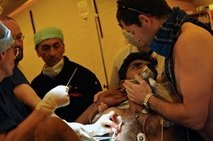 The X-ray shows a bullet lodged next to the heart of a Tamil man, one of tens of thousands who have flooded out of Sri Lanka’s northeast to escape the war with the Tamil Tigers.
The X-ray shows a bullet lodged next to the heart of a Tamil man, one of tens of thousands who have flooded out of Sri Lanka’s northeast to escape the war with the Tamil Tigers.
"He said he was shot in the chest six months ago. But we can’t remove it because we’d have to do full open-chest surgery," said Michel Orcel, a doctor working in a French field hospital set up on the island.
Over the last two weeks, the team of 72 surgeons, doctors, nurses and other staff have already treated 700 people, 100 of whom have been put on the operating table.
And under the scalpel, the skinny and traumatised displaced have given a gruesome picture of how Tamil civilians have paid a heavy price in what the island’s government says has been a "rescue mission."
Their wounds show how ordinary and impoverished villagers — male and female, young and old — have been shot, shelled, bombed and burned as the bitter ethnic conflict enters its bloody final phase.
One surgeon, Daniel Gaujoux, said he was "stunned by the number of machine gun bullets and shrapnel we are pulling out" from civilians who managed to escape.
"We’ve removed 30 bullets in 10 days — around 10 of them from the arms and legs of children, and even one from the knee of an old woman," said Frederic Vavdin, another member of the French government aid team.
One young girl, 12-year-old J. Nitharsana, was lucky to keep her foot.
Her father, V. Jegathaesvaran, said she was wounded a month ago by the Tamil Tigers — who have been accused of keeping civilians as human shields to slow a fierce government onslaught.
Another one of the wounded, 36-year-old Susenthiran Thiressamma, was nursing horrific burns to her chest and shoulders. She said she was "burned by a chemical bomb" two weeks ago.
Doctors at the French field hospital said they had seen a number of similar injuries, including "some with white hands, possibly caused by burns from phosphorus" — an incendiary weapon which is banned from use in civilian areas under an international convention.
Both the Sri Lankan government and the Tamil Tigers have accused each other of using chemical weapons, charges each have denied.
With the island’s hawkish government severely restricting access to the north, independent monitoring of how the war is being conducted is almost non-existent.
However, the Sri Lanka’s defence ministry last week granted permission to AFP to visit the French field hospital at Cheddikulam, 90 kilometres (56 miles) south-west of the war zone.
According to a United Nations document circulated among diplomats last month, around 6,500 Tamil civilians are thought to have been killed and 14,000 wounded in the government’s offensive since the start of the year.
And in March, the UN’s human rights chief Navi Pillay said both the government and the Liberation Tigers of Tamil Eelam (LTTE) — who have been fighting for an independent state since the 1970s — may have committed war crimes.
But the Sri Lankan government is brushing off any criticism, and says the remaining guerrillas have been confined to a five-square-kilometre (two-square-mile) area in the district of Mullaittivu.
It estimates that up to 20,000 civilians are still being held by the LTTE as human shields, while the UN has said the number could be as high as 50,000.
At the field hospital, the doctors are reluctant to point fingers at either side — aware that the Sri Lankan government does not take kindly to foreign criticism, and has expelled aid workers before.
(For updates you can share with your friends, follow TNN on Facebook and Twitter )
